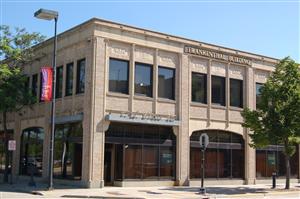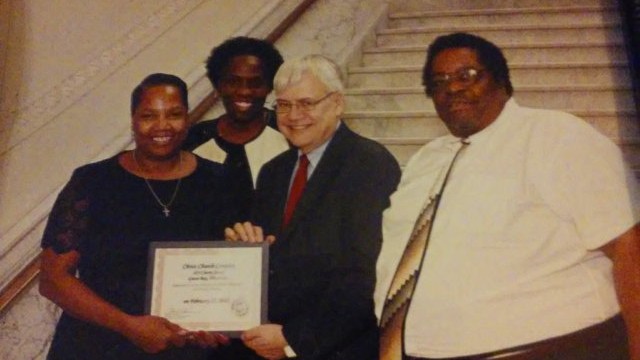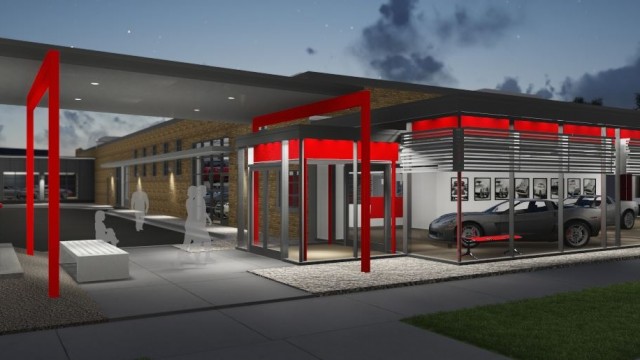Each year the Historic Preservation Committee of the Brown County Historical Society presents awards to businesses, organizations and individuals for their efforts to preserve, restore, and adapt for reuse, vintage and historic buildings in Brown County. These awards are presented at the Society’s annual meeting each February.
The following is a listing of our most recent honorees, the 2015 recipients of the BCHS Historic Preservation Awards:
The Frankenthal Building, Green Bay
130 N. Adams has been a prominent building in downtown Green Bay for nearly 90 years. In 1928, Harvey Barnard and Charles Cady, prominent area bankers, realtors, and land developers, built the present building with features in the Mediterranean Style. Named the Cady-Barnard Building, it housed their Cady Land Company business, as well as other smaller tenants. Starting in the 1930s, the then 20 year old C.A. Gross Men’s Clothiers moved into the building, where it became a 90 year old Green Bay institution. In 1983, the building was purchased by Howard Frankenthal, who in addition to other smaller tenants, housed his own business office on the second floor. When the C.A. Gross Co. went out of business in 2003, a large portion of the building remained without a major tenant for nearly 10 years. In 2013, Wells Fargo Commercial Banking and Wealth Management agreed to occupy 5000 square feet of the first floor. After a new boiler, new HVAC, and new fit out, Wells Fargo opened their new location in October 2015. The renovated historic building looks forward to beginning its second century in downtown Green Bay.
National Register Nomination and Listing for the Divine Temple Church of God in Christ, Green Bay
In 2005, The Divine Temple Church of God in Christ purchased the former Christ Episcopal Church at 425 Cherry Street as their new home. Christ Episcopal Church’s long history was closely tied to Green Bay’s early development, starting with the parish’s incorporation in 1829 and Daniel Whitney’s presentation of its current site for a church in 1831. In 1839, they worshipped in a new frame church building on Cherry St. until it was destroyed by fire in 1898, but then replaced by the present stone masonry structure in 1899. In 2008, soon after the Divine Temple Church acquired the historic buildings, church member Sharon Harper attended a meeting that focused on historic properties where the former Christ Episcopal Church building was mentioned. She remembers little of the meeting itself, other than leaving with a strong desire to research the building’s history and write a nomination to the National Register of Historic Places. She soon found out what a daunting undertaking this would be. Pastor Green encouraged her but at the same time warned her that others had tried but given up due to the difficulty of the project. Because of the complexity of preparing a nomination, the Wisconsin Historical Society’s Division of Historic Preservation strongly recommended that the Church hire an historian experienced in preparing nominations. Knowing that the Church didn’t have funds to pay an expert, and maybe not fully comprehending the task in front of her, Sharon plunged into the project. Before she could actually start doing research, she had to learn how to research, how to describe architectural styles and features, how to write a historical analysis, how to closely adhere to rigorous technical instructions, and how to properly provide historical documentation and complete the nomination form. With the strength of her Faith, the belief and support from Pastor Green, and assistance and encouragement from Deputy State Historic Preservation Officer Daina Penkiunas Ph.D., she embarked on what turned out to be a four year journey. Sharon spent months in several libraries, including the Episcopal Church Archdiocese archives in Fond du Lac, WI. Finally, in 2012, the WHS Preservation staff visited the Church and verified the survey, and later that year, a ribbon cutting ceremony was held on the front steps of the Church to celebrate Sharon’s and the Church’s extraordinary efforts, the placing of the Church’s complex of buildings on the State and National Register of Historic Places.
The Automobile Gallery, Green Bay
About 8 years ago, William “Red” Lewis, the founder of PDQ Car Wash and the inventor of the “Touchless Car Wash” system, was considering his life after semi-retirement. He had restored classic automobiles as a hobby all his life, but with approximately 60 cars in different storage garages across the area, he finally asked his daughter Becky “What are you going to do with all these after I’m gone?” Those initial conversations served as the seed for what was to become The Automobile Gallery, a non-profit showroom where classic automobiles serve as both an exhibit for individual visitors as well as the backdrop for gatherings in an event center and an executive conference room. The visualization of this idea began when the Denil Cadillac building on Adams St. became available. The building was a state-of-the-art Cadillac dealership when it was built in 1959, but after it closed in the early 2000s, it was used only as storage for the county Sherriff’s Department and other small businesses. The idea of converting the former auto dealership building into an auto gallery was an exciting concept not only for the Lewis family but also for the Denil family, who enthusiastically supported the project. Based on architectural designs by Somerville, Inc., the former dealership building, including showroom, repair area, and prep area, have been restored and renovated into a unique state-of-the-art gallery, event, and meeting spaces that are drawing groups and events from across the country. With Red’s cars and those from other collectors being rotated into the display, The Automobile Gallery has become an embodiment of Red’s dream of a space where “The Automobile is the Art”.



